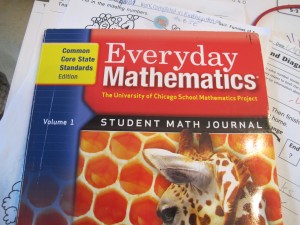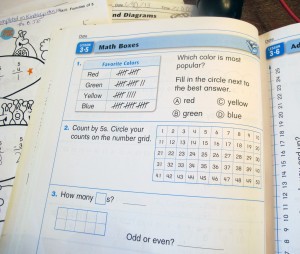How The Common Core Is Changing Math Instruction For Indiana's Youngest Students

Elle Moxley / StateImpact Indiana
Many Indiana schools are using Everyday Mathematics, curriculum that is aligned to the Common Core State Standards.
Indiana’s youngest students are learning math in a different way than their parents or even older siblings.
That’s because the new Common Core academic standards have changed how teachers introduce math in the early grades. In classrooms across the state, you’ll find kindergarten and first grade students using blocks and interlocking cubes to learn how to add and subtract.
Architects of the nationally crafted academic standards say kids need a better foundation in math skills before moving on to more advanced concepts and operations. But some parents and math scholars argue the new standards just don’t add up.
“The problems are always written sideways,” says Indianapolis parent Suzanne Sherby. “There’s just nothing that looks like traditional math.”
- 'We Changed Math Curriculum And The Papers That Started Coming Home Were Just Crazy'StateImpact Indiana‘s Elle Moxley explains how first grade math homework led to a statehouse push to withdraw Indiana from the Common Core.Download
How Math Homework Led To Pushback Against New Standards
The use of math tools — called “manipulatives” — in the early grades isn’t new. But as Indiana schools transition to Common Core, more teachers are breaking out the blocks to ensure young students leave with a conceptual understanding of basic arithmetic.
“Students are doing a lot of hands-on work, so you see and hear students learning a lot more,” says John Newport, curriculum coordinator for Vigo County Schools. “With Common Core State Standards and the standards for mathematical practice, that’s really what they’ve been focusing on.”
For several years the district has used a curriculum called Everyday Math, which emphasizes teaching a variety of strategies and methods to solve problems. So Newport says parents in Vigo County are already familiar with the Common Core’s hands-on approach to math.But parents at other schools say elementary math instruction has changed so much they’ve formed a group called Hoosiers Against the Common Core that’s leading a statehouse push to withdraw Indiana from the new standards.
“At our school, the first thing we noticed is we changed math curriculum and the papers that started coming home were just crazy,” says Sherby, who’s gotten involved with Hoosiers Against the Common Core. “You’d look at them and think, well, what did they want them to write?”
Sherby slides one of her son’s math worksheets across the table. She says it looks much different than the assignments her older child brought home just a few years ago.
“So you start looking at it, and you see your child missed 11 minus 5 because he wrote 11 minus 5 was 6, but he forgot to draw 11 pairs of pants and cross 5 of them out,” says Sherby.
Where The Standard Algorithm Fits Into The Common Core
You probably learned to add using the standard algorithm. The numbers would be written on top of each other, and you’d work from right to left, adding the ones, then the tens, then the hundreds.
Sherby’s son is learning a different way, called regrouping. Instead of putting 243 on top of 162, the numbers are pulled apart and written next to each other: 200 plus 100, 40 plus 60, 3 plus 2. Teaching kids to add the sums helps them understand where each number is coming from, says Doug Clements, a mathematics and early childhood education researcher at the University of Denver who helped write the Common Core standards.
“Do we want the kids adding in columns? Absolutely. Eventually,” he says.
But not before they’re ready. Clements says the committee that wrote the Common Core standards started with a narrative of how math concepts develop. So the standard algorithm is still there, it just isn’t taught until kids have more of a foundation in math.
“The fact that it was made for the days of the Bob Cratchits, right? Who had to sit all day on a stool and add columns and figures?” says Clements. “So we wanted it to be an efficient kind of process, which has separated it from its conceptual and mathematical roots.”
Why Some Mathematicians Say Common Core Lowers The Bar
But mathematicians who oppose the Common Core point to a different Dickens character: Tiny Tim. Ze’ev Wurman says regrouping is just a crutch that delays teaching the standard algorithm.
“It meanders and messes around with all these great looking strategies that don’t always work,” says Wurman, who sat on the committee that reviewed the Common Core State Standards in California.

Elle Moxley / StateImpact Indiana
A group of parents called Hoosiers Against The Common Core say homework and workbooks aligned to the new standards don't look like traditional math.
Wurman says adults who already know how to add, subtract, multiply and divide understand there’s more than one way to do basic arithmetic. But he says if you’re 6 and your teacher shows you several ways to solve a problem, you’ll probably be confused as to which method you should pick.
“And by the Common Core delaying the expectation of fluency for a year or two, it opens a door to fill the previous year with a lot of fooling around — if I’ll put it bluntly — and confusing children,” he says.
Wurman says the Common Core might raise the bar in states whose standards weren’t strong before. But Indiana already had good academic standards — some say more rigorous than the Common Core. They weren’t preparing students for college and career, though. The state’s community colleges spend $35 million a year remediating students who aren’t ready for college-level math.
Podcast: Play in new window | Download

